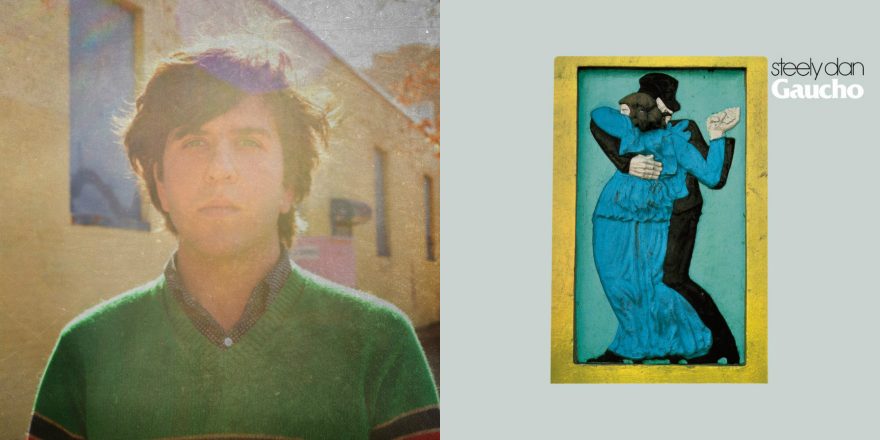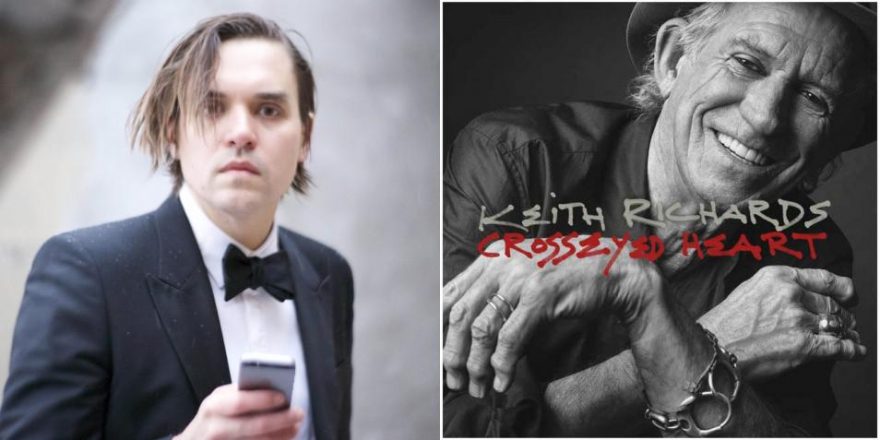It was December 2005. I was sitting alone with my iBook in the lobby of the Best Western Windjammer Hotel in Burlington, Vermont, on my very first tour with Frank Zappa tribute act Project/Object. That’s when I stumbled upon Steely Dan’s 1980 album, Gaucho. As a drummer, I was looking into the history of Bernard “Pretty” Purdie and his infamous “Purdie Shuffle” groove. Wading through painfully geeky drum forums led me to Gaucho’s ice-cold opener, “Babylon Sisters,” and there was something about the song that struck a nerve with me. Perhaps it was the self-deprecating tone in singer Donald Fagen’s nasal delivery, the slinky shuffle, or the polyrhythmic backup vocals. As an inexperienced eighteen-year-old navigating a plethora of new feelings, this breezy midlife crisis vignette shook me to my very core.
Steely Dan is in the midst of a bit of a resurgence, having headlined Coachella 2015. I’m not a bandwagoner, though; I’m a staunch Danatic, through and through, and have been something of a Dan counselor to the uninitiated. I know it can be tough to wrap your mind around lyrical esoterica and crunchy Mu Major electric piano chords. If you’re around me long enough, though, I’ll try to convince you that Steely Dan belong in the upper echelon of rock worship.
When I was in jazz school in 2005 at University of the Arts in Philadelphia, I bonded with my future best friend Dominic over The Dan. We would later share songwriting duties in our band Lithuania, a subtle nod to Fagen and his co-conspirator Walter Becker. We were also indebted to our punk heroes the Minutemen, who brilliantly covered “Dr. Wu” (from 1975’s Katy Lied) on their 1984 magnum opus Double Nickels on the Dime. Dominic and I are adjacent signs (Aries and Taurus), astrologically speaking (Fagen and Becker are Capricorn and Aquarius, respectively).
I’m not a bandwagoner, though; I’m a staunch Danatic, through and through, and have been something of a Dan counselor to the uninitiated.
I’ve learned so much from Steely Dan over the years, musically and lyrically. I’m in the midst of working on a new Lithuania album, and their storytelling is influencing my more character-driven songs. Our first album, 2015’s Hardcore Friends, was very direct — almost too direct. A representative for a very large clothing company wanted to use our songs until he realized how personal they were. He told us, “I need some material that matches the emotional equivalent of a twelve-year old’s brain. Sorry.”
I want to write from a personal perspective, but the ambiguity of The Dan’s lyrics has me crossing out lines and becoming more vague. I feel like I achieved some opacity a few years ago with a solo track I released called “Nothing is Real.” Here’s a sample lyric: “If I still do it when no one’s around/will I seem happier to them/into the dark with your arms behind your head/oh no.” Keeping it mysterious is becoming ever elusive in our world of data overload.
One of Dominic and my chief topics of conversation when it comes to The Dan is this: what if they were more brilliant than we realize? What if they were composing one big musical novel with recurring characters? What if the homeless heroin addict in 1974’s “Charlie Freak” was a Memento-style flashback from the seedy lead character in 1977’s “I Got the News”? Being a student of Frank Zappa’s music made me understand that conceptual continuity was possible. “Suzy Creamcheese” was a mysterious name that re-appeared in dozens of Zappa compositions. Frank Zappa even said, in 1974, “The myth of Suzy Creamcheese, I wrote myself. There never really was a Suzy Creamcheese. It was just a figment of my imagination until people started identifying with it heavily. It got to weird proportions in Europe, so that in 1967, when we did our first tour of Europe, people were asking if Suzy Creamcheese was along with us.”
Perhaps Steely Dan was pulling a Zappa, but in a much less direct way. Zappa and Steely Dan created a mythical narrative, and I wanted to do that with my music. I was influenced by this smokescreen when I wrote my first Lithuania song in 2008, “Deaf Gene” (from our overlooked Heavy Hands EP). It’s about a man who’s driven to violent insanity by listening to music. It was half based on my imagination and half based on Mark David Chapman. I was also influenced by the lawsuit over Black Sabbath’s “Suicide Solution,” which came after a disgruntled teenager committed suicide after listening to Ozzy allegedly proclaim, “Get the gun, shoot shoot shoot.” I’m still fascinated by the intrinsic power of lyrics, even when there is no malicious intent.
What if they were more brilliant than we realize? What if they were composing one big musical novel with recurring characters?
In 2012, I got a copy of The Believer in the mail that confirmed a lot of my own suspicions about The Dan. In Peter Coviello’s revealing essay “The Talk That Does Not Do Nothing,” he speculates that “Rikki Don’t Lose That Number” (from 1974’s Pretzel Logic) and “Deacon Blues” (from 1977’s Aja) actually share characters and plotlines. Peter made an interesting point, but the piece didn’t go far enough when it came to exploring this idea — it focused more on bullshitting about music with your friends. I knew the theory needed development. Steely Dan basically wrote their own Infinite Jest, with deep anecdotal footnotes and a separate dictionary to boot.
Below, I’ll try to tie up some loose ends when it comes to what I call “The Dan Vinci Code.” Much as happened in Dan Brown’s detective novel, The Da Vinci Code, Steely Dan has left a smattering of clues and codes that should hopefully lead to some big transcendent reveal. Maybe Mary Magdalene IS buried underneath this jazzy pyramid. I feel that my long-time favorite track, “Babylon Sisters,” is a great place to start.
Fagen and Becker used biblical terminology (The Fall of Babylon) to describe Chuck’s self-destructive behavior. I can’t help but feel that Fagen/Becker were influenced by this imagery during the problematic Gaucho sessions. Becker was becoming more dependent on narcotics after breaking his leg in a car accident, and to make matters even worse, he was involved in a wrongful death lawsuit after his girlfriend, Karen Stanley, died of a drug overdose in his apartment. Fagen and Becker were forced to write for six months via the telephone. This was at the height of The Dan’s perfectionism. They allegedly mixed “Babylon Sisters” a whopping two hundred and seventy-four times and spent fifty-five mixes alone on just the fade-out. Gaucho was the last Steely Dan record of their classic winning streak. Their personal Babylonian Empire had crumbled. They broke up after Gaucho and wouldn’t record again until 1999.
But let’s get back to the lyrics.
The second verse reveals more of Chuck’s insecurities and delves into some arcane references to Kirschwasser, a very uncool cherry brandy that an older man such as Chuck might enjoy sharing with his ladies. During the weekend’s intimate climactic ménage, Chuck realizes that he doesn’t have the stamina of his youth. He can’t keep coercing women into his dead-end follies: “Well I should know by now. …/Like a Sunday in T.J./That it’s cheap but it’s not free/That I’m not what I used to be/And that love’s not a game for three.”
Lithuania used a similar lyrical lamentation on our song “2009” from the album Hardcore Friends. The chorus goes, “I’d rather be a monster/than responsible/for my crimes.” We were and still are heavily influenced by The Dan, especially with the song’s open major second suspended chords.
The third verse is where things get really dark. “My friends say no don’t go/For that cotton candy.” Chuck ends his selfish weekend with an ill-advised cocaine snort and sits back as the unfulfilled women leave him at his Laurel Canyon condo. The last words signify a bleak and true Hollywood ending: “The Kid will live and learn/As he watches his bridges burn/From the point of no return.”
I’d like to make the argument that Chuck “Kid Charlemagne” Steiner is a recurring character in The Dan’s oeuvre. One could link his behavior to the reckless drug dealer in 1976’s “Kid Charlemagne” from The Royal Scam. The use of the name Charlemagne is brilliant, as King Charlemagne (Charlemagne means Charles the Great) was an imperial ruler after the fall of the Roman Empire. There goes that Empire motif again. “Kid Charlemagne” is based on Owsley’s LSD exploits in San Francisco. Unsurprisingly, “Charlemagne” and “Babylon Sisters” share a San Francisco thread. Perhaps Chuck starts his career as a drug-lord in San Francisco and then ends up as a wealthy junkie burnout in L.A.?
“Kid Charlemagne: “Those San Francisco nights/You were the best in town.”
“Babylon Sisters”: “San Francisco show and tell.”
This has to be the same manic character. At the beginning of “Charlemagne,” Chuck is at the top of his dealing game. There’s another religious reference here: “Did you feel like Jesus/Did you realize/That you were a champion in their eyes.” We then get echoes of his future penchant for traveling to Los Angeles: “Every A-frame had your number on the wall/You must have had it all/You’d go to L.A. on a dare and you’d go it alone.” I believe “Charlemagne” is written mostly from a friend’s perspective. Right now we’ll call him Rick, but this may have to change down the line as I untangle more mysteries.
Finally, we learn that Chuck has to flee San Francisco for L.A. or else he’ll get busted by the fuzz for cooking up large batches of acid: “Clean this mess up else we’ll all end up in jail/Those test tubes and the scale/Just get them all out of here.” His story connects and picks up again at the beginning of “Babylon Sisters”: “Drive west on Sunset to the sea.”
I don’t want to spoil too much about the next Lithuania record, but Dominic and I are working hard to create a plotline that goes deeper than the banal façade of traditional pop song structure. Steely Dan has been blaring in our tour van for the last year. I’m not ashamed to admit it. We’ve bonded with fellow punks about their private Dan-aticisms and plan on spreading the gospel as time goes on. As you can see, I’m just beginning to scratch the surface of a vast narrative. I’m excited to fall down the rabbit holes and step on the landmines that The Dan has set for me as a writer and listener. Until next time.
TO BE CONTINUED…








